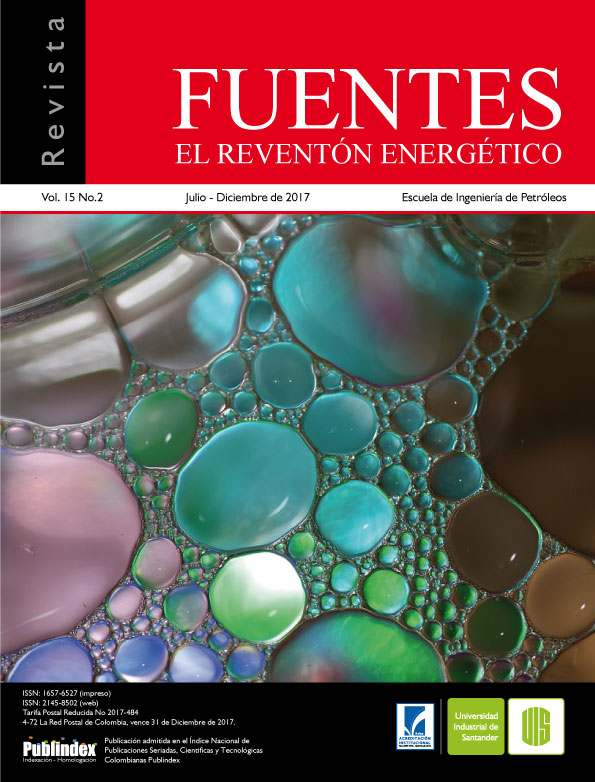Análisis de presión y derivada de presión para pozos fracturados asimétricamente con fractura de conductividad finita
Published 2017-12-15
Keywords
- Conductividad de fractura,
- Análisis de Pruebas de Presión,
- Técnica TDS,
- Pozos fracturados
How to Cite
Abstract
Muchos investigadores han desarrollado ecuaciones para caracterizar fracturas hidráulicas asumiendo que éstas son simétricas con respecto al pozo puesto que las fracturas simétricas son menos probable que ocurran. Por lo tanto, puesto que no existe una metodología analítica directa que permita una adecuada interpretación utilizando la derivada de presión para determinar la asimetría de la fractura, la posición del pozo con respecto a la fractura, la conductividad de fractura y la longitud media de la misma. Por ello, aquí se presenta la metodología TDS que utiliza líneas y puntos característicos hallados en los gráficos loglog de presión y derivada para desarrollar ecuaciones analíticas usadas para determinar en forma simple, práctica y exacta los parámetros anteriormente mencionados. La técnica se verificó satisfactoriamente con problemas sintéticos.
Downloads
References
2. Bennett, C. O., Rosato, N. D., Reynolds, A. C., & Raghavan, R. (1983). Influence of Fracture Heterogeneity and Wing Length on the Response of Vertically Fractured Wells.
Society of Petroleum Engineers, 23 (02). doi:10.2118/9886-PA.
3. Bernal, K.M., Escobar, F.H., & Ghisays-Ruiz, A. (2014a). Pressure and Pressure Derivative Analysis for Hydraulically-Fractured Shale Formations Using the Concept of Induced
Permeability Field. Journal of Engineering and Applied Sciences, Vol. 9 (10), 1952-1958. ISSN 1819-6608.
4. Cinco-Ley, H., Samaniego V., F., & Dominguez, A., N. (1978, August 1). Transient Pressure Behavior for a Well With a Finite-Conductivity Vertical Fracture. SPE Journal. 18(4), 253-264. doi:10.2118/6014-PA.
5. Bostic, J. N., Agarwal, R. G., & Carter, R. D.(1980). Combined Analysis of PostfracturingPerformance and Pressure BuildupData for Evaluating an MHF Gas Well. Society of Petroleum Engineers, 32 (10).doi:10.2118/8280-PA.
6. Escobar, F.H., Lopez, A.M. & Cantillo, J.H. (2007). Effect of the Pseudotime Function on Gas Reservoir Drainage Area Determination.CT&F – Ciencia, Tecnología y Futuro, 3 (3), 113-124. ISSN 0122-5383.
7. Escobar, F.H., Zhao, Y.L., & Zhang, L.H.(2014b). Interpretation of Pressure Tests in Hydraulically-Fractured Wells in Bi-Zonal Gas Reservoirs. Ingeniería e Investigación Journal, 34 (4), 76-84. ISSN 0120-5609.
8. Escobar, F.H., Castro, J.R. & Mosquera, J.S. (2014c). Rate-Transient Analysis for Hydraulically Fractured Vertical Oil and Gas Wells. Journal
of Engineering and Applied Sciences, 9 (5), 739-749. ISSN 1819-6608.
9. Escobar, F.H., Montenegro, L.M. & Bernal, K.M. (2014d). Transient-Rate Analysis For Hydraulically-Fractured Gas Shale Wells Using The Concept Of Induced Permeability Field”. Journal of Engineering and Applied Sciences, 9 (8), 1244-1254. ISSN 1819-6608.
10. Escobar, F.H., Ghisays-Ruiz, A. & Bonilla, L.F. (2014e). New Model for Elliptical Flow Regime in Hydraulically-Fractured Vertical Wells in Homogeneous and Naturally-
Fractured Systems. Journal of Engineering and Applied Sciences, 9 (9), 1629-1636. ISSN 1819-6608.
11. Escobar, F.H., Zhao, Y.L. & Fahes, M. (2015). Characterization of the naturally fractured reservoir parameters in infinite-conductivity hydraulically-fractured vertical wells by transient pressure analysis. Journal of Engineering and Applied Sciences, 10 (12), 5352-5362.
12. Escobar, F.H., Gonzalez, R.A., Hernandez, L.M. & Hernandez, C.M. (2016). Pressure and Pressure Derivative Analysis for Hydraulically Fractured Vertical Wells with Face Skin. Journal of Engineering and Applied Sciences, 11 (13), 8268-8273.
13. Narasimhan, T. N., & Palen, W. A. (1979). A Purely Numerical Approach For Analyzing Fluid Flow To A Well Intercepting A Vertical Fracture. Society of Petroleum Engineers. doi:10.2118/7983-MS.
14. Nunez, W., Tiab, D., & Escobar, F. H. (2003). Transient Pressure Analysis for a Vertical Gas Well Intersected by a Finite-Conductivity Fracture. Society of Petroleum Engineers. doi:10.2118/80915-MS.
15. Resurreicao, C. E. S., & Fernando, R. (1991). Transient Rate Behavior of Finite-Conductivity Asymmetrically Fractured Wells Producing at Constant Pressure. Society of Petroleum Engineers. doi:10.2118/22657-MS
16. Rodriguez, F., Cinco-Ley, H., & Samaniego-V., F. (1992). Evaluation of Fracture Asymmetry of Finite-Conductivity Fractured Wells. Society of Petroleum Engineers, 7 (02). doi:10.2118/20583-PA.
17. Tiab, D. (1994). Analysis of Pressure Derivative without Type-Curve Matching: Vertically Fractured Wells in Closed Systems. Journal of Petroleum Science and Engineering 11 (1994) 323-333. This paper was originally presented as Tiab, D. (1993, January 1). Analysis of Pressure and Pressure Derivative without Type- Curve Matching - III. Vertically Fractured Wells in Closed Systems. Society of Petroleum Engineers. doi:10.2118/26138-MS
18. Tiab, D. (1995). Analysis of Pressure and Pressure Derivative without Type-Curve Matching: I-Skin and Wellbore Storage. Journal of Petroleum Science and Engineering, Vol. 12, pp. 171-181.Also Tiab, D. (1993, January 1). Analysis of Pressure and Pressure Derivatives Without Type-Curve Matching: I-Skin and Wellbore Storage. Society of Petroleum Engineers. doi: 10.2118/25426-MS.
19. Tiab, D., Azzougen, A., Escobar, F. H., & Berumen, S. (1999, January 1). Analysis of Pressure Derivative Data of Finite-Conductivity Fractures by the “Direct Synthesis” Technique. Society of Petroleum Engineers. doi:10.2118/52201-MS.
20. Tiab, D. (2003). Advances in pressure transient analysis — TDS technique. Lecture Notes Manual. The University of Oklahoma, Norman, Oklahoma, USA. 577p.
21. Tiab, D., & Bettam, Y. (2007). Practical Interpretation of Pressure Tests of Hydraulically Fractured Wells in a Naturally Fractured Reservoir. Society of Petroleum Engineers. doi:10.2118/107013-MS.
22. Zhao, Y.L. Escobar, F.H., Hernandez, C.M., & Zhang, C.P. (2016). Performance Analysis of a Vertical Well with a Finite-Conductivity Fracture in Gas Composite Reservoirs. ARPN Journal of Engineering and Applied Science1819-6608, 11 (15), 8992-9003.
